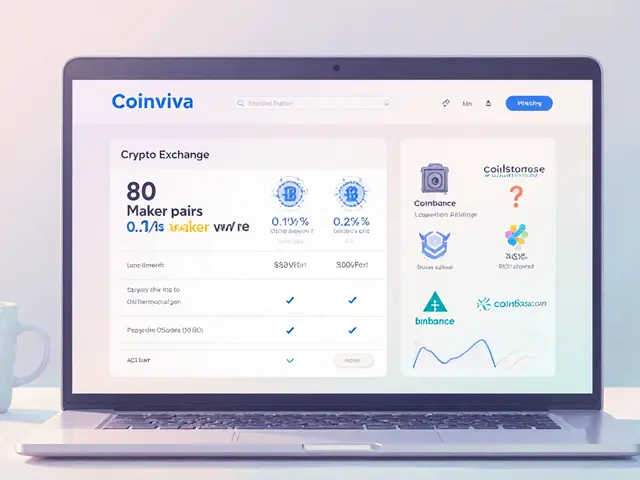Liquidity Mining vs Yield Farming: How to Choose the Right DeFi Strategy

DeFi Strategy Comparison Tool
Yield Farming
Chase the highest APY by hopping between protocols
Liquidity Mining
Provide liquidity for trading pairs to earn fees
Strategy Comparison
| Aspect | Yield Farming | Alternative |
|---|---|---|
| Primary Goal | Maximize APY by hopping across protocols | Provide trading liquidity for a specific pair |
| Reward Source | Interest + governance tokens | Swap fees + optional governance tokens |
| Risk Profile | High - Smart-contract risk, high gas, token volatility | Medium - Impermanent loss + smart-contract risk |
| Required Activity | Frequent rebalancing or use of aggregators | One-time deposit (optional periodic re-balancing) |
| Typical Platforms | Yearn, Aave, Compound, Curve (farm mode) | Uniswap, SushiSwap, PancakeSwap, Curve |
Risk Assessment
Common Risks
- Smart-contract bugs
- Impermanent loss (specific to liquidity mining)
- Market volatility
- Gas fees
- Rug pulls and protocol failures
When to Use Each Strategy
Yield Farming: When you enjoy active management and want to maximize returns through protocol hopping.
Liquidity Mining: When you want to support trading liquidity and earn steady fee income.
Quick Start Guide
Yield Farming Quick Start
- Pick a reputable aggregator (e.g., Yearn)
- Connect your wallet
- Select a vault matching your risk tolerance
- Deposit desired amount
- Enable auto-compounding if available
- Monitor APY weekly
Liquidity Mining Quick Start
- Choose a DEX with a trusted pool
- Calculate equal-value amounts of two assets
- Add liquidity using platform UI
- Track earned fees via dashboard
- Check impermanent loss regularly
- Adjust position if IL becomes too high
People keep mixing up liquidity mining and yield farming, but the two tactics serve different purposes in the world of Decentralized Finance (a set of financial services built on public blockchains without traditional intermediaries). If you want to earn a steady stream of crypto without holding it idle, you need to understand where the money comes from, how risky each move is, and what tools can make the job easier. This guide breaks down both strategies, puts them side‑by‑side, and gives you a clear roadmap for deciding which one fits your risk appetite and time budget.
TL;DR
- Yield farming hops between many protocols to chase the highest APY; liquidity mining locks funds in a specific pool to earn fees and token rewards.
- Liquidity mining carries higher impermanent‑loss risk because you’re exposed to price swings of two assets.
- Yield farming demands active monitoring or automation; liquidity mining is simpler but still needs pool‑specific knowledge.
- Use yield aggregators (e.g., Yearn) for hands‑off farming; use concentrated liquidity tools (e.g., Uniswap V3) for efficient mining.
- Start small, test on trusted platforms like PancakeSwap, Curve, or SushiSwap, and always check audits.
What Is Yield Farming?
Yield farming is a broad umbrella term for any DeFi activity that seeks to generate the highest possible Annual Percentage Yield (APY) by moving crypto assets across multiple smart contracts. In practice, you deposit a token into a protocol that offers a base interest, then the protocol hands out extra governance tokens (native tokens that grant voting rights and often carry additional market value) as a sweetener. The more you chase, the more you’ll switch between lending platforms, liquidity pools, and even synthetic asset markets.
Typical yield‑farming steps look like this:
- Choose a high‑APY pool on a platform such as Yearn or Aave.
- Deposit your assets and receive a receipt token (often called a cToken or a token that represents your share in the lending pool).
- Earn interest plus extra governance tokens.
- Re‑invest (auto‑compound) or move to a new pool when a better rate appears.
The upside is potentially double‑digit or even triple‑digit APY, but the downside includes transaction costs, exposure to multiple smart‑contract bugs, and the need to stay on top of market shifts.
What Is Liquidity Mining?
Liquidity mining narrows the focus to providing liquidity for a decentralized exchange (a platform that lets users trade tokens directly from their wallets via smart contracts) or an automated market maker (a type of DEX that prices assets using a mathematical formula instead of order books). You lock up a pair of tokens-say ETH and USDT-in equal value, receive a liquidity‑provider (LP) token that tracks your share, and start earning a slice of the swap fees. Many platforms also sprinkle extra governance tokens on top, effectively rewarding you for keeping the market liquid.
The core steps are simpler:
- Select a pool (e.g., ETH/USDT on Uniswap V3).
- Deposit equal value of both assets.
- Collect LP tokens and start earning trading fees plus any protocol‑issued rewards.
- Withdraw whenever you want, bearing the risk of impermanent loss (the temporary loss in value compared to holding the assets separately, caused by price divergence).
Liquidity mining is the engine that makes DEXs function; without LPs, there’s no liquidity and trades would fail.
Key Differences at a Glance
| Aspect | Yield Farming | Liquidity Mining |
|---|---|---|
| Primary Goal | Maximize APY by hopping across protocols | Provide trading liquidity for a specific pair |
| Reward Source | Interest + governance tokens | Swap fees + optional governance tokens |
| Risk Profile | Smart‑contract risk, high gas, token volatility | Impermanent loss + smart‑contract risk |
| Required Activity | Frequent rebalancing or use of aggregators | One‑time deposit (optional periodic re‑balancing) |
| Typical Platforms | Yearn, Aave, Compound, Curve (farm mode) | Uniswap, SushiSwap, PancakeSwap, Curve |
Risk Factors You Must Know
Both strategies share common dangers, but each has its own quirks.
- Smart‑contract bugs: If the code that holds your funds is flawed, you could lose everything. Look for audited contracts and reputable auditors.
- Impermanent loss (IL): Specific to liquidity mining. The farther the price ratio of the two assets drifts, the bigger the IL compared to simply holding the tokens.
- Market volatility: Sudden price moves can wipe out APY calculations and trigger liquidations on leveraged farms.
- Gas fees: On Ethereum Layer‑1, high gas can eat most of your profit. Layer‑2 solutions (Arbitrum, Optimism) or alternative chains (BNB Chain, Polygon) help.
- Rug pulls and protocol failures: New projects may disappear with user funds. Stick to platforms with strong community backing and open‑source code.

When to Use Yield Farming
If you enjoy active management and have the time (or money for automation), yield farming can squeeze extra returns out of idle assets. Ideal scenarios include:
- You have a stablecoin that you want to earn more than the 5‑10% staking rates offered by most blockchains.
- You want exposure to emerging governance tokens that may appreciate beyond the base yield.
- You’re comfortable using aggregators like Yearn, which automatically shift your capital to the highest‑yielding vault.
Remember, the higher the APY, the more likely the reward is driven by token emissions rather than real economic activity. Treat those returns as speculative upside.
When to Use Liquidity Mining
Liquidity mining shines when you believe a specific market pair will see strong, steady trading volume. Good fits are:
- You want to support a favorite DEX or a new token launch that promises deep pools.
- You’re comfortable holding two assets for the long term and can tolerate price swings.
- You want to earn a predictable share of swap fees, which can be more stable than token rewards.
Concentrated liquidity (Uniswap V3) lets you place capital in a narrower price range, reducing IL while still collecting fees. This is perfect for assets you expect to stay within a tight band.
Tools and Automation
Manual hopping is tiring, so many traders rely on tools:
- Yield aggregators: Yearn, Autofarm, and Beefy automate vault selection and compounding.
- Liquidity dashboards: Zapper, Zerion, and Debank track LP token balances, fee earnings, and IL metrics.
- Concentrated liquidity calculators: Uniswap’s official UI or third‑party calculators help you set optimal price ranges.
- Risk‑monitoring bots: Services like Furucombo can set alerts for large price deviations that would trigger high IL.
Using these tools doesn’t eliminate risk, but it does give you clearer data and saves time.
Step‑by‑Step Starter Guide
Yield Farming Quick‑Start
- Pick a reputable aggregator (e.g., Yearn).
- Connect your wallet (MetaMask, Trust Wallet).
- Select a vault that matches your risk tolerance (stablecoin, ETH‑based, or mixed).
- Deposit the desired amount; the platform will issue a receipt token.
- Enable auto‑compounding if available.
- Monitor APY every week; re‑allocate only if a significantly higher vault appears.
Liquidity Mining Quick‑Start
- Choose a DEX with a pool you trust (Uniswap V3, PancakeSwap, or Curve).
- Calculate the equal‑value amounts of the two assets you’ll provide.
- Use the platform’s ‘Add Liquidity’ UI; you’ll receive an LP token.
- Track your earned fees via a dashboard (Zapper works well).
- Periodically check the impermanent loss calculator to see if fees are outpacing IL.
- If IL becomes too high, consider withdrawing or moving to a narrower price range.
Bottom Line
Yield farming and liquidity mining are two sides of the same DeFi coin. One emphasizes chasing the highest APY across many protocols; the other focuses on locking capital into a specific pool to keep markets liquid. Your choice boils down to how much time you want to spend, how comfortable you are with price‑movement risk, and whether you prefer a hands‑on or semi‑automated approach. Start small, use trusted tools, and keep an eye on the three big threats: smart‑contract bugs, impermanent loss, and gas fees. With a disciplined mindset, both strategies can become reliable sources of crypto‑based passive income.
Frequently Asked Questions
Is liquidity mining more profitable than yield farming?
Profitability depends on the specific pool and market conditions. Liquidity mining can yield steady fee income, but high impermanent loss can erase those gains. Yield farming may offer higher nominal APY thanks to token rewards, yet those rewards are often speculative. The safest way is to compare the net APY after accounting for fees and IL for the pool you’re eyeing.
Do I need to provide two different tokens for liquidity mining?
Yes. Most AMM pools require a 50/50 value split of two assets (e.g., ETH/USDT). Some newer designs allow single‑asset provision, but the classic model still dominates.
Can I use the same wallet for both strategies?
Absolutely. A single non‑custodial wallet (MetaMask, Ledger, etc.) can interact with any DeFi contract. Just keep track of each protocol’s token approvals to avoid unnecessary gas spend.
How do I calculate impermanent loss?
The standard formula is IL = 2·√(P) / (1+P) - 1, where P is the price ratio change of the two assets. Many dashboards provide an instant IL calculator, so you usually won’t need to crunch the numbers manually.
Is it safer to stick to one platform for both activities?
Sticking to well‑audited, high‑TVL platforms reduces smart‑contract risk, but diversification still matters. Using a single platform can simplify tracking, yet a breach on that platform would affect all your capital.







Great breakdown! The side‑by‑side table really helps visualise the core differences. I love how you highlighted the risk profile for each strategy – that’s often overlooked. For anyone just starting out, focusing on the “required activity” column can guide whether you prefer a hands‑off or active approach. Keep the clear, concise guides coming! 😊
Sounds like hype to me. 😑
The dichotomy between liquidity mining and yield farming is often misrepresented in popular discourse, leading to suboptimal allocation of capital. A thorough analysis requires distinguishing not only the superficial reward mechanisms but also the underlying economic incentives that drive participant behavior. Yield farming, by design, seeks to maximize the annual percentage yield through dynamic reallocation across multiple protocols, thereby exposing the investor to compounded smart‑contract risk. Conversely, liquidity mining anchors capital within a specific pool, generating returns primarily from transaction fees and, occasionally, supplemental governance tokens. The risk calculus for each approach diverges fundamentally: yield farming amplifies exposure to token volatility and gas fee volatility, whereas liquidity mining introduces impermanent loss as a principal concern. Moreover, the temporal commitment differs; yield farming often necessitates weekly or even daily monitoring, while liquidity mining may tolerate a more static position, albeit with periodic rebalancing considerations. From an asset‑allocation perspective, an investor with a high risk tolerance and a proclivity for active management may find yield farming aligns with their strategic objectives. In contrast, a risk‑averse participant seeking predictable fee income should gravitate toward liquidity mining, preferably on established platforms with robust audit histories. It is also imperative to assess the governance token distribution models; inflationary token emissions can artificially inflate APY figures, masking the true economic return. The effective APR after accounting for token vesting schedules and market dilution often reveals a more modest yield than advertised. Practitioners should also be vigilant about the composability layer-interacting with multiple protocols increases attack vectors, as demonstrated by several high‑profile exploits in the past year. Therefore, a disciplined approach involving thorough due diligence, continuous monitoring, and prudent position sizing is essential regardless of the chosen strategy. Finally, diversification across both strategies can mitigate idiosyncratic risks while capturing upside from each avenue. By allocating a modest portion of capital to yield farming and the remainder to liquidity mining, investors can balance active return seeking with stable fee income. In summary, the decision hinges on individual risk appetite, time commitment, and confidence in the underlying protocol security.
Adopting a structured framework for evaluation will empower participants to navigate the evolving DeFi landscape with greater resilience.
Listen up, if you’re going to dive into liquidity mining you need to understand the concept of “impermanent loss” and how it interacts with the pool’s constant product formula. The LP tokens you receive represent your share of the pool’s reserves, and any price divergence between the paired assets directly erodes your effective capital. Mitigate this by selecting‑stablecoin pairs or employing concentrated liquidity strategies on Uniswap V3 to narrow your price range. Also, always audit the smart contract source code; a single vulnerability can wipe out the entire incentive pool in seconds. Stay sharp, run the numbers, and don’t forget to monitor the fee‑to‑loss ratio continuously.
Yo, the thrill of yield farming is like surfing a wave of ever‑rising APY-if you catch it at the crest you can ride those returns to the moon! But remember, the ocean’s surface can be deceiving; hidden currents of gas fees and contract bugs can pull you under. Use aggregators like Yearn to automate the grind and keep your capital flowing into the highest‑yielding vaults. Keep your eyes on the horizon, rebalance before the tide turns, and you’ll stay ahead of the pack. Trust the process and let the compounding magic do its thing.
Good summary of the two approaches. The table makes comparison easy to read. I appreciate the clear risk notes.
Let’s set the record straight: liquidity mining isn’t just a side hustle, it’s the backbone of any sovereign DeFi ecosystem. By providing deep order books you enable true financial independence for local users, reducing reliance on foreign intermediaries. Don’t be fooled by flash‑farm hype that only benefits offshore token speculators. Focus on native pairs, audit the contracts, and you’ll see sustainable growth without capitulating to external control.
Reading through this guide feels like a breath of fresh air in the often‑confusing DeFi jungle; the way you’ve juxtaposed the risk profiles really paints a vivid picture for newcomers. I especially love the practical quick‑start sections-they’re like step‑by‑step roadmaps that anyone can follow without a PhD in blockchain. The emphasis on gas‑fee mitigation and layer‑2 alternatives shows a deep awareness of real‑world constraints that many articles gloss over. Your balanced view of when to use each strategy helps readers align their personal risk appetite with the appropriate toolset. It’s clear you’ve put a lot of thought into making this accessible yet thorough, and that level of care is commendable. Keep up the excellent work, and I’m excited to see more such insightful content in the future.
Sure, hopping across farms looks shiny, but remember that “high APY” often masks unsustainable token emissions. 🚀
The allure of astronomical yields is a siren song that preys on our deepest fears of missing out, yet it blinds us to the looming abyss of smart‑contract failure. In the end, we are all chasing ghosts in a digital ether.
Yield farming is a glorified gamble, and most participants are just reckless gamblers in disguise.
Don’t let the complexity scare you-start with a simple stable‑coin pair and watch the fees accrue. 🤝 Regularly check the impermanent loss calculator to stay confident in your position. You’ll get the hang of it faster than you think!
The entire DeFi hype train is a wreck waiting to happen. Most “strategies” are just elaborate Ponzi schemes built on faulty code.
In the grand tapestry of decentralized finance, each strategy is a thread weaving its own pattern. Yield farming offers the bright, chaotic colors of ambition, while liquidity mining provides the steady, muted hues of stability. Both have their place, and appreciating the balance is a meditative exercise. When you step back, the overall picture becomes more meaningful.
It would be remiss to assert that liquidity mining invariably yields superior returns; empirical data suggests otherwise in many market cycles. Moreover, the regulatory scrutiny surrounding token incentives cannot be dismissed lightly. A prudent investor should therefore evaluate both vectors with equal rigor.
Hey folks, if you’re feeling stuck between farming and mining, just remember you can blend both-allocate a slice of your portfolio to each and enjoy the best of both worlds. Use tools like Zapper to keep track of everything in one dashboard. It’s all about finding that sweet spot where effort meets reward.
All this DeFi talk is just buzzwords for the same old speculation.
I appreciate how this guide lays out the pros and cons without pushing a single agenda. It’s refreshing to see a balanced perspective that respects both active and passive participants. The inclusion of risk‑monitoring tools like Furucombo adds practical value for users at any skill level. By providing clear steps for both strategies, readers can make informed choices aligned with their personal goals. Thanks for the thorough work.
This article nails the essentials and adds handy dashboards for real‑time tracking. I’d also suggest checking out Debank for a consolidated view of LP positions and token rewards. 📊 Remember, the best practice is to always compare net APY after fees and potential impermanent loss. Keep experimenting, and you’ll find the sweet spot that matches your risk tolerance.
The promised “steady fee income” is often a mirage when market volume drops, leaving LPs with negligible returns. Moreover, the underlying tokenomics can introduce hidden dilution effects that erode real gains.
Respect the process, but don’t let fear freeze your capital. Start small, monitor the pool’s performance, and adjust as needed. You’ll build confidence and see real results over time.
Loving the clear tables-makes the decision process almost painless. For anyone on the fence, try a tiny test deposit in a well‑audited pool and see how the fees feel. It’s a low‑risk way to get hands‑on experience.
DeFi is wild but also a learning curve. Watching the fees versus loss over weeks tells a lot. Keep an eye on gas spikes too.
Stay disciplined and review your positions regularly. Use the dashboards to track earnings and adjust for impermanent loss. Consistency will pay off in the long run.